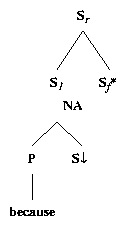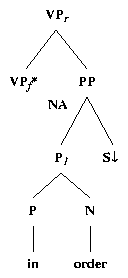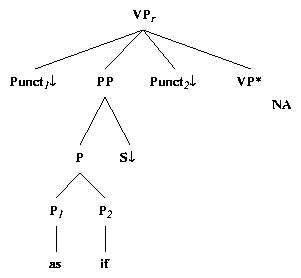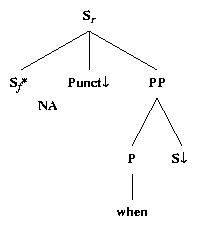



 |
 |
 |
 |
| (1) Pss | (2) vxPNs | (3) puPPspuvx | (4) spuPs |
Sentence-initial adjuncts adjoin at the root S of the matrix clause, while sentence-final adjuncts adjoin at a VP node. In this, the XTAG analysis follows the findings on the attachment sites of adjunct clauses for conditional clauses ([#!iatridou91!#]) and for infinitival clauses ([#!Browning87!#]). One compelling argument is based on Binding Condition C effects. As can be seen from examples ((283))-((285)) below, no Binding Condition violation occurs when the adjunct is sentence initial, but the subject of the matrix clause clearly governs the adjunct clause when it is in sentence final position and co-indexation of the pronoun with the subject of the adjunct clause is impossible.
We had previously treated subordinating conjunctions as a subclass of conjunction, but are now assigning them the POS preposition, as there is such clear overlap between words that function as prepositions (taking NP complements) and subordinating conjunctions (taking clausal complements). While there are some prepositions which only take NP complements and some which only take clausal complements, many take both as shown in examples ((286))-((289)), and it seems to be artificial to assign them two different parts-of-speech.
Each subordinating conjunction selects the values of the <mode> and <comp> features of the subordinated S. The <mode> value constrains the types of clauses the subordinating conjunction may appear with and the <comp> value constrains the complementizers which may adjoin to that clause. For instance, indicative subordinate clauses may appear with the complementizer that as in ((290)), while participial clauses may not have any complementizers ((291)).